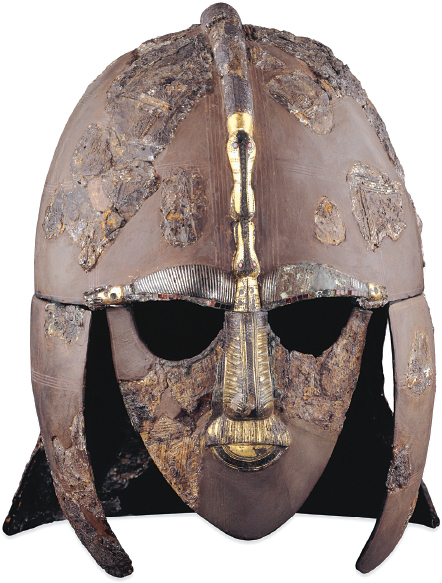Migrations and Political Change
Migrating groups that the Romans labeled barbarians had moved southward and eastward off and on since about 100 C.E. (see “Political Measures” in Chapter 6). Why did the barbarians migrate? In part, they were searching for more regular supplies of food, better farmland, and a warmer climate. Conflicts within and among barbarian groups also led to war and disruption, which motivated groups to move. Roman expansion led to further movement of barbarian groups but also to the blending of cultures.

Anglo-Saxon HelmetThis ceremonial bronze helmet from seventh-century England was found inside a ship buried at Sutton Hoo. The nearly 100-foot-long ship was dragged overland before being buried completely. It held one body and many grave goods, including swords, gold buckles, and silver bowls made in Byzantium. The unidentified person who was buried here was clearly wealthy and powerful, and so was very likely a chief. (© The Trustees of the British Museum/Art Resource, NY)
The spread of the Celts presents a good example of both conflict and assimilation. Celtic-speaking peoples had lived in central Europe since at least the fifth century B.C.E. and had spread out from there to the Iberian Peninsula in the west, Hungary in the east, and the British Isles in the north. As Julius Caesar advanced northward into what he termed Gaul (present-day France), he defeated many Celtic tribes (see “The Late Republic and the Rise of Augustus” in Chapter 6). Celtic peoples conquered by the Romans often assimilated to Roman ways, intermarrying with Romans, adopting the Latin language and many aspects of Roman culture. By the fourth century C.E., however, Gaul and Britain were under pressure from Germanic groups moving westward. Roman troops withdrew from Britain, and Celtic-speaking peoples clashed with Germanic-speaking invaders, of whom the largest tribes were the Angles and the Saxons. Some Celtic-speakers moved farther west. Others remained and intermarried with Germanic peoples, their descendants forming a number of small Anglo-Saxon kingdoms.
In eastern Europe, a significant factor in barbarian migration and the merging of various Germanic groups was pressure from nomadic steppe peoples from central Asia, most prominently the Huns, who attacked the Black Sea area and the Eastern Roman Empire beginning in the fourth century. Under the leadership of their warrior-king Attila, the Huns attacked the Byzantine Empire in 447 and then turned westward, allying with some Germanic groups and moving into what is now France. After Attila turned his army southward and crossed the Alps into Italy. Though papal diplomacy was later credited with stopping the advance of the Huns, their dwindling food supplies and a plague that spread among their troops were probably much more important factors. The Huns retreated from Italy, and within a year Attila was dead. The Huns never again played a significant role in European history. Their conquests had pushed many Germanic groups together, however, which transformed smaller bands of people into larger, more unified peoples who could more easily pick the Western Roman Empire apart.
After they conquered an area, barbarians generally established states ruled by kings. However, the kingdoms did not have definite geographical borders, and their locations shifted as tribes moved. Eventually, barbarian kingdoms came to include Italy itself. From Constantinople, Eastern Roman emperors such as Justinian (see “Justinian’s Code of Law”) worked to reconquer at least some of the West from barbarian tribes. They were occasionally successful but could not hold the empire together for long.
How were barbarian societies organized?
